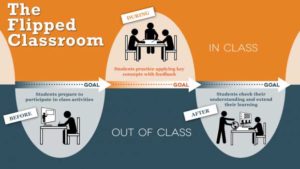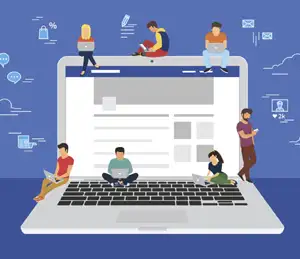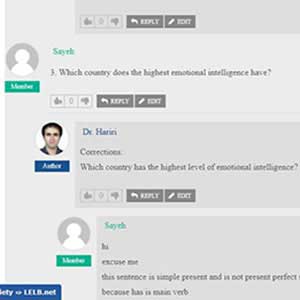Table of Contents
- What is asynchronous learning?
- Flexibility in class time
- Asynchronous learning and flipped learning
- Durability of online resources
- Synchronous merged with asynchronous learning
- Parental supervision and monitoring
- Promoting learner autonomy
- Portfolio assessment in asynchronous learning
- Endorsing peer-assessment
- Skills integration in asynchronous learning
- Meaningful learning and asynchronous learning
- Asynchronous learning is more cost-effective
- When isn’t asynchronous learning recommended?
Do you want to get more familiar with the emerging concept of asynchronous learning in online education? In this article, we’re going to compare and contrast asynchronous learning with synchronous learning in the growing realm of online courses, particularly second language acquisition.
What is asynchronous learning?

Asynchronous learning refers to any educational method or curriculum that is not limited to any specific time. In other words, this type of learning does not necessarily occur in synchronous or live classes, either online or physical. As a result, this form of education emphasizes learner-centeredness and student-student interaction.
Asynchronous learning could yield a variety of benefits for both teachers and students. In this article, we’re going to delineate the numerous advantages of employing asynchronous learning, particularly in the real of second language acquisition.
Flexibility in class time

As implied in the preceding paragraph, in asynchronous learning, the concept of fixed class time is so inconsiderable. This is because learning occurs at any time that is convenient to both teacher and students. While we’re talking about it, in synchronous learning, the main area of focus is live classes at fixed times.

Consequently, asynchronous learning could greatly benefit students and teachers with hectic schedules. For instance, businessmen, entrepreneurs, managers, engineers, etc. can ideally tap into this form of education without much difficulty.

However, it should be pointed out that students and teachers must be able to manage their time effectively in non-synchronous learning. In other words, time management is a crucial aspect of non-synchronous learning. For this particular reason, asynchronous education is not recommended to young learners who might not be prepared to manage their time efficiently.
Asynchronous learning and flipped learning

With the intention of improving the quality of education in online courses, it seems to be logical to amalgamate asynchronous learning with flipped learning. At LELB Society, you can vividly experience this smart amalgamation.
Feeding students with recorded lectures or presentations is one of the building blocks of any flipped class. In other words, instead of attending live lectures and presentations, students are provided with previously recorded lectures. As a result, depending on their proficiency level and preparation, students can play and listen to the lectures as many time as required.
At LELB Society, which is a bilingual academy of English and Persian, almost for each lesson, there is an embedded video for our students. In other words, we’ve already taught all the lessons on English and Persian.
Durability of online resources

Unlike synchronous classes in which teachings are not generally recorded, and therefore, disappear over time, in asynchronous learning, online resources provided by teachers and lessons planners are recorded and archived. For instance, at LELB Society, which is a bilingual academy of English and Farsi, we’ve developed and published over 4,000 English and Persian lessons enriched with embedded videos and nested comment forms to promote student interaction.
These lessons have reached 5,100+ comments and replies, which per se indicates how interactive we have been since the birth of LELB Society back in 2015. The archived lessons at LELB Society alongside student interaction in the form of comments and replies in comment forms and discussion boards can perfectly be used by new students in new terms or semesters, thanks to WordPress as a leading blogging system in the world.
Synchronous merged with asynchronous learning

It is perfectly possible to run an education system primarily asynchronously and yet supplement it with periodic synchronous classes through, for example, video conferencing, webinars, and the like. This mixture of synchronous and asynchronous learning can guarantee even more immediate feedback.
In his close observation lasting for approximately a decade, Dr. Mohammad Hossein Hariri Asl, the founder and chief administrator at LELB Society, has found out that asynchronous learning does not receive adequate attention from language learners all around the world.
One major reason that contributes to this unfortunate drawback in non-synchronous education is lack of immediacy in teacher’s feedback. Students, especially young learners and even their parents, prefer to receive immediate feedback or interaction in the social context where learning takes place.
For this reason, why not supplement asynchronous education with periodic live classes, webinars, Internet Relay Chat (IRC) for immediate messaging, video conferencing, and the like. I’ve found it extremely useful to elaborate on the numerous benefits of asynchronous learning in synchronous and live channels of communication, such as live classes and webinars.
Parental supervision and monitoring

Unlike synchronous classes where parents don’t normally have any clue on what’s going on in the class, in asynchronous learning, parents can monitor the learning curve and track the academic progress of their children. They simply need to log in to their children’s accounts, accessing and assessing their scholastic activities and performances.
Teachers and parents can interact with each other both synchronously and asynchronously from time to time through, for example, feedback forums, webinars, workshops, and the like. Students are also cognizant of this fact that they are being monitored by both their teachers and parents.
Promoting learner autonomy
According to Oxford University Press website, learner autonomy is student’s preparedness and ability to self-regulate their own learning consciously and critically. Implementing asynchronous education can practically boost student autonomy because learners actually need to regulate their own learning, for example through portfolio assessment.
Learners gradually understand they are not spoon-fed by the teacher all the time, and they need to stand on their own feet. Accordingly, they take more active and responsive roles in learning, which makes them less teacher-dependent. In the following paragraphs, more information will be provided on the significance of utilizing portfolio assessment in online education.
Portfolio assessment in asynchronous learning

With regard to learner autonomy, the concept of portfolio assessment is of primary importance. A student portfolio refers to the collection of assigned lessons and materials and student’s academic contribution and interactivity in response to the assigned lessons within a particular time frame to achieve specific goals and objectives.
At LELB Society running on WordPress as a pioneer content-management system (CMS), we’ve been using one special forum built with bbPress for student portfolio assessment. In this forum, our students are able to track their own academic progress over time as they can easily access and monitor the stream of their academic activities in interaction with the teacher.
Student portfolio assessment, which is updated asynchronously but frequently, can turn out to be the cornerstone of authentic and continuous evaluation throughout the online course. That’s why we believe that portfolio assessment, which falls into the category of formative assessment, can make a perfect substitute for final examinations as a kind of summative assessment.
Endorsing peer-assessment

Asynchronous learning has this potential to augment peer-assessment in the form of student-student interaction taking place in comment forms and forums through computer-mediated communication or CMC. In our Round Table activity theorized and implemented for the first time by Dr. Mohammad Hossein Hariri Asl, each student is expected to study an assigned lesson and watch the corresponding video asynchronously and before the class.

Then he/she should make a question about the assigned lesson and leave it in the comment form at the bottom of the lesson. Another task on the part of the student is to reply to one of the existing comments or questions before the upcoming live class. Students are encouraged to correct each other’s grammar mistakes offline as an out-of-class activity. They are also motivated to give their own feedback on their peers and even teacher’s comments pragmatically and semantically.

Finally, in our live or synchronous classes, we generally focus on students’ comments and replies that sometimes reach for 100 threads in one single post or lesson. In his PhD dissertation on realizing social presence in online learning environments, Dr. Mohammad Hossein Hariri Asl understood that teacher’s immediacy in responding to the comments and replies could be counterproductive because it can impede and discourage peer-assessment in the form of student-student interaction. For this reason, he voluntarily delayed providing immediate feedback to trigger more peer-assessment.
To provide a better user experience for our students, Dr. Mohammad Hossein Hariri Asl, who has also developed and maintained the online community of LELB Society from 2015, has installed and optimized asynchronous channels of communication, namely comment forms and discussion boards.
Technically speaking, these communication channels are nested or threaded. In other words, it is easy to distinguish comments from replies as the latter are indented or threaded. Nested comment forms and forums can greatly facilitate peer-assessment in asynchronous learning.
Skills integration in asynchronous learning
As mentioned in the preceding paragraphs, asynchronous learning can encourage skills integration in a fairly natural and practical fashion. In our round table activity, students can perfectly experience skills integration in the following ways:
- Listening practice: Students first watch an embedded video or podcasts in the form of a presentation, lecture, narration, documentary, and the like.
- Reading practice: Students read or study specified passages above or below the embedded videos or podcasts on the same topic before the live classes. They can also select any text and listen to it, thanks to our installed text-to-speech software program.
- Writing practice: Students are supposed to write at least one comment and one reply in the interactive comment form at the bottom of each lesson. They are encouraged to practice peer-assessment occurring in the comment forms before our live classes.
- Speaking practice: In our live classes, we’ll have informed discussions over the asynchronous comments and replies. The students can also leave voice messages asynchronously before online classes to practice speaking interactively anytime, anywhere.
Meaningful learning and asynchronous learning
If employed correctly, asynchronous learning can account for deep and meaningful learning because of the following:
- Students have more time to study and digest the assigned lessons and respond to them.
- Students can learn from each other interactively through peer-assessment at their own convenience.
- Students can carry out further research and reading to fill in the gap if the specified materials are not sufficient.
- Learning process is more process-oriented rather than product-oriented.
- Students have to take totally active and responsive roles in learning.
- Students can evaluate their own performance throughout the term through authentic and portfolio assessment.
Asynchronous learning is more cost-effective

In addition to the above-mentioned advantages of asynchronous learning, it should also be added that this form of education is far more cost-effective in comparison to synchronous learning, which exclusively relies on live classes taught by teachers or tutors. Of course, the reason is crystal clear; teachers don’t need to teach countless classes one after another.

Instead of teaching many identical classes in succession, teachers can teach a flipped class in advance in the form of a recorded lecture or presentation. Then this recorded teaching could easily be deployed in unlimited classes of the same ilk. Furthermore, these flipped classes could perfectly be enriched with student contributions and interaction, namely informed comments and replies.
When isn’t asynchronous learning recommended?
Despite all the benefits of asynchronous learning, it should be pointed out that it is, for sure, not the perfect model of education in all situations. We’ve made a list of all cases in which asynchronous learning in its entirety is not generally advisable:
- Asynchronous learning cannot be used ideally to teach and instruct young learners who need constant support and rely on anticipation of rewards.
- Being a relatively new form of education, asynchronous learning fails to be a viable methodology for students and teachers who are not culturally and educationally ready for this paradigm shift in the third millennium.
- Not all social contexts and online learning environments are suitable for implementing asynchronous learning. In fact, this form of education requires a robust infrastructure from a technological point of view and a large comprehensive database from an educational point of view.
- Ordinary teachers are not capable of flipping classes asynchronously. On the contrary, flipped learning undoubtedly need teachers who are double experts. For instance, in the field of second language acquisition, language teachers are expected to be computer-assisted language learning or CALL practitioners, as well.
- Asynchronous or flipped learning is not recommended to elementary students, particularly in the realm of second language acquisition. This is because these students, like young learners, depend on constant and immediate feedback on the part of the teacher.
- Asynchronous learning should be amalgamated with content-based instruction to spark adequate interest in students and motivate them to carry on learning on their own. Uninteresting and useless themes and subject matter will certainly demotivate students in the long run.
